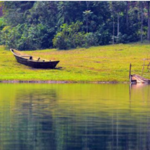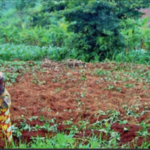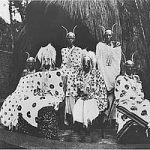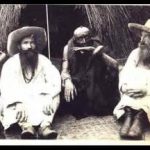Beans, Sorghum, Peas & Maize
Beans
Nutritionally speaking, beans are the most important crop. They are the largest source of protein for the people of Remera. The people themselves seem to recognize this fact in that they say they have “more strength” when they eat beans rather than plantain.
All varieties of beans are sown together, although the peasants know the different characteristics and values of each variety.
The leaves of beans, in general, are called umushogoro. The first young leaves to appear are known as umujanja. They are often picked and cooked in time of famine. The second growth of leaves may be picked young and cooked with fresh beans in season; together they are called umureka, while the fresh beans alone are umutonore. These two latter foods are eaten and enjoyed outside of famine periods.
For storage purposes, however, the majority of the beans are left to ripen and dry on the plant. The plants are then pulled up by the roots and flailed on the rugo floor. The beans thus extracted, are ready for storage.
Beans are planted for both the urugaryi and impeshi harvest. Every opportunity of planting them is taken. They are sown under growing banana plants. (The peasants have a tendency to extend this practice to the newly imported crops of coffee and manioc. One of the tasks of the Agricultural Service is to convince them that this decreases their yield.) Beans are also grown with maize, as guhungira. When sown with peas the crop is called amahunge. They can even be sown in the lowlands in July and harvested in November. There they thrive better on the slopes immediately bordering the bottomlands, than at lower levels.
Sorghum
It appears that sorghum has been slowly taking the place of eleusine (finger millet), so that no eleusine whatsoever is grown in Remera.
Sorghum does not seem to be eaten often, although a paste can be made with the flour. However, it is essential to the making of beer. In sorghum beer, it is obviously the principal element, and in banana beer, the degerminated grain is used to encourage fermentation.
An indirect use of sorghum lies in the fact that the stubble is left to grow again after the June harvest, as fodder for the cows during the dry season.
Sorghum is a one crop per year cereal. It is planted at the end of January or at the beginning of February and is harvested in June. It prefers dry soils and therefore fares better on the summit than in the swamps where it rots from too much humidity.
At harvest time, the stalk is cut at the base, but for storage only the top part of the stalk, bearing the head of grain is kept. (The rest of the stalk can be used for making fences, roof covering, etc.)
Peas
Peas are undoubtedly grown mostly for the reason that once planted they do not require weeding, as do the beans (according to the peasants). Moreover, they may produce a crop a month ahead of the beans. However, if the Banyaremera have beans, they would rather not eat peas, because they feel they tend to cause indigestion.
Peas are sown in mid-March, one month later than the beans. It is not usual to sow them in September, but a few handfuls of peas might be sown then with the beans and harvested one month earlier among the unripe beans. The peas are harvested and stored in the same manner as the beans.
Maize
Maize is not an important crop in Remera. As stated above, it is never sown alone — always with beans. It is, however, much appreciated by the Banyaremera and is treated as a delicacy rather than as a staple.
Most of the crop is eaten roasted in the fields, as taken from the standing stalks. It is the only food that is eaten “publicly”, so to speak, and regularly between meals. Children while tending goats eat a great proportion of the crop. Because of the nature of this type of consumption, it is difficult to evaluate the quantifies consumed and the total harvest.
https://uk.amateka.net/beans-sorghum-peas-maize/https://uk.amateka.net/wp-content/uploads/2021/03/smbpp.pnghttps://uk.amateka.net/wp-content/uploads/2021/03/smbpp-150x150.pngAgricultureModel CitizenshipBeans Nutritionally speaking, beans are the most important crop. They are the largest source of protein for the people of Remera. The people themselves seem to recognize this fact in that they say they have 'more strength' when they eat beans rather than plantain. All varieties of beans are sown...BarataBarata rpierre@ikaze.netAdministratorAMATEKA | HISTORY OF RWANDA




